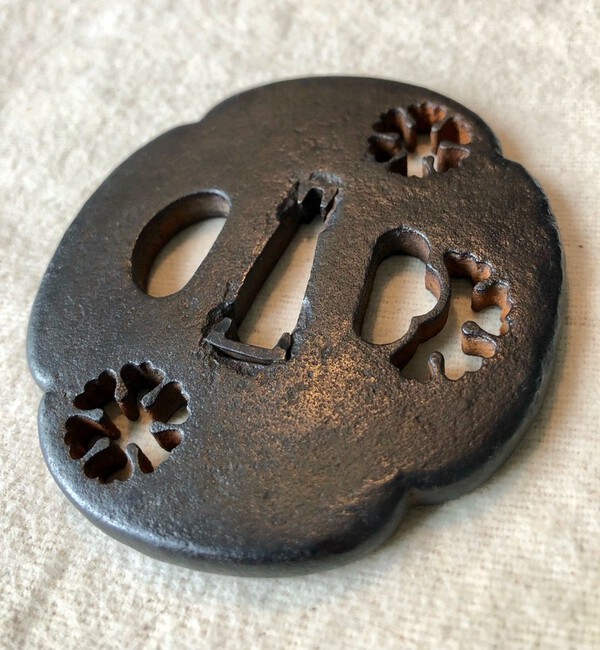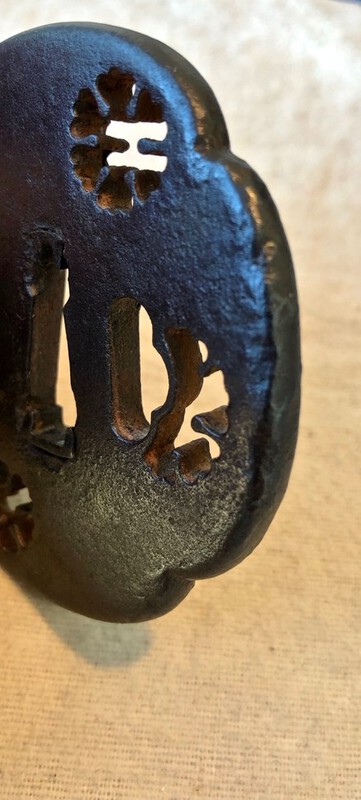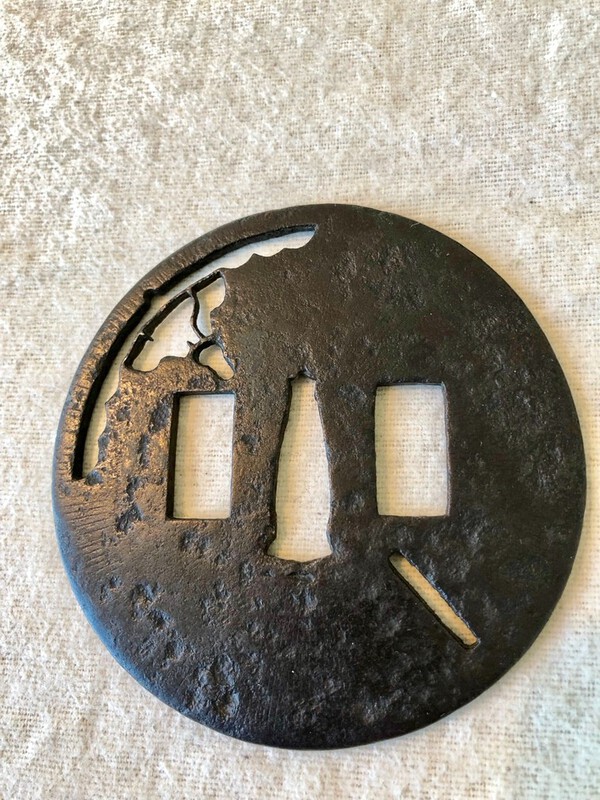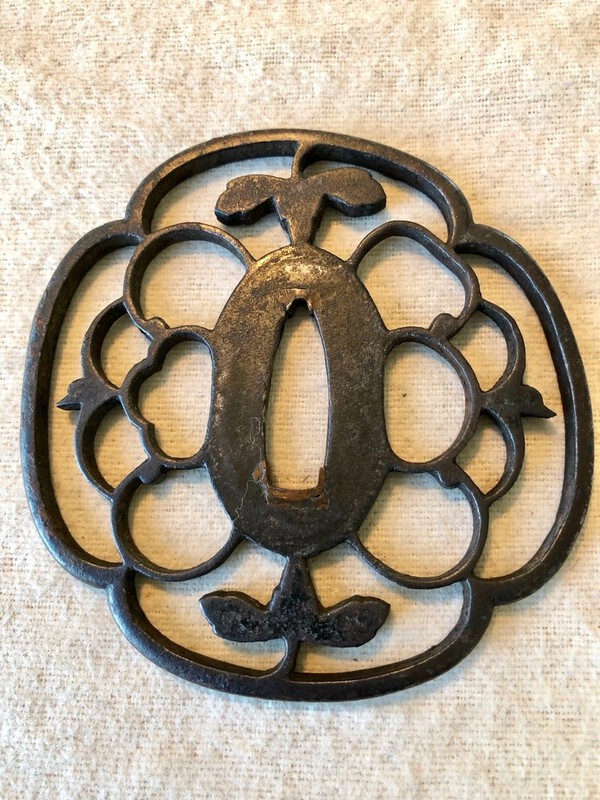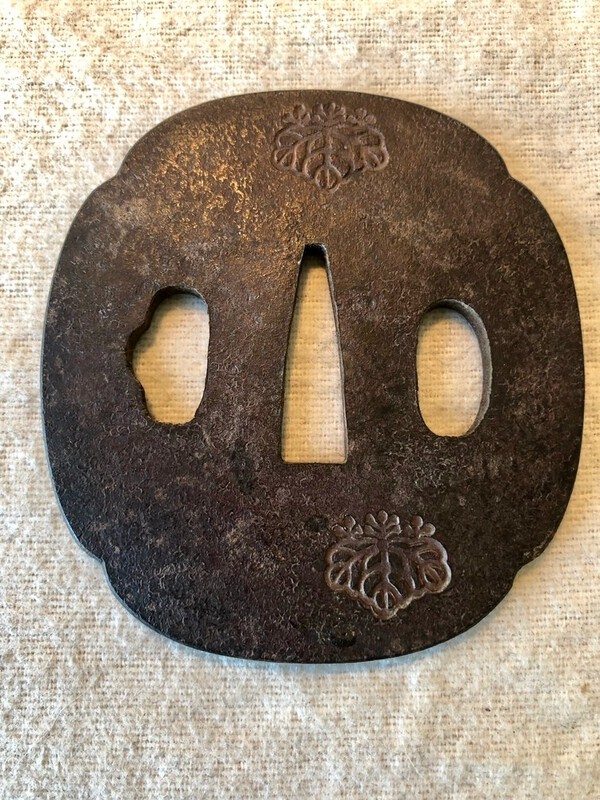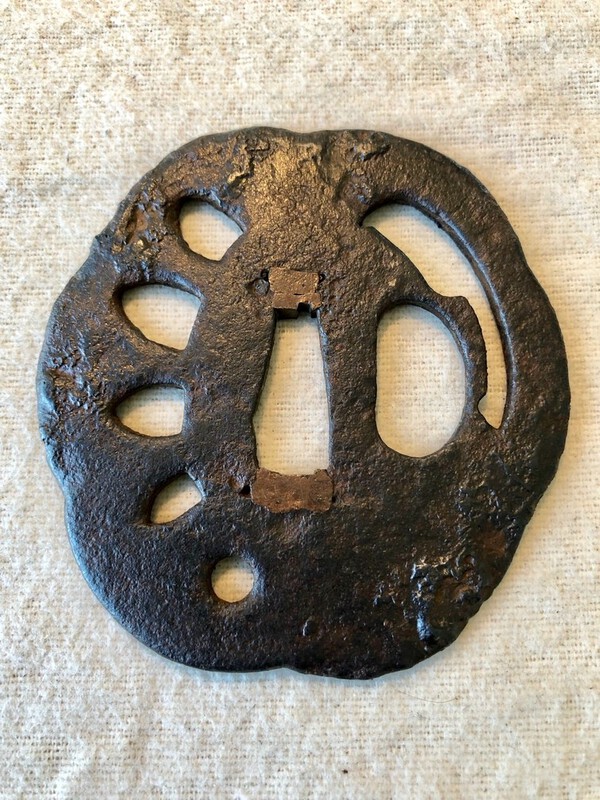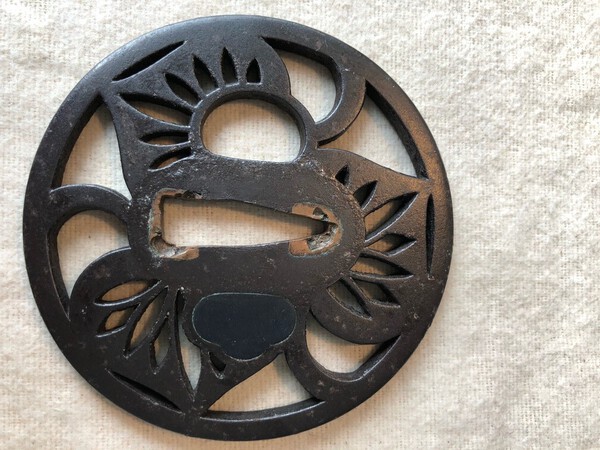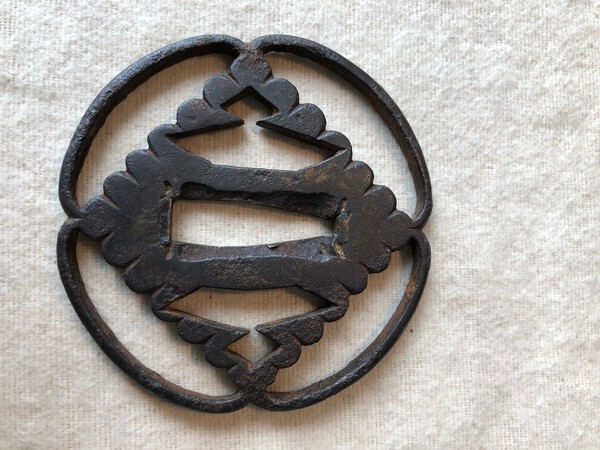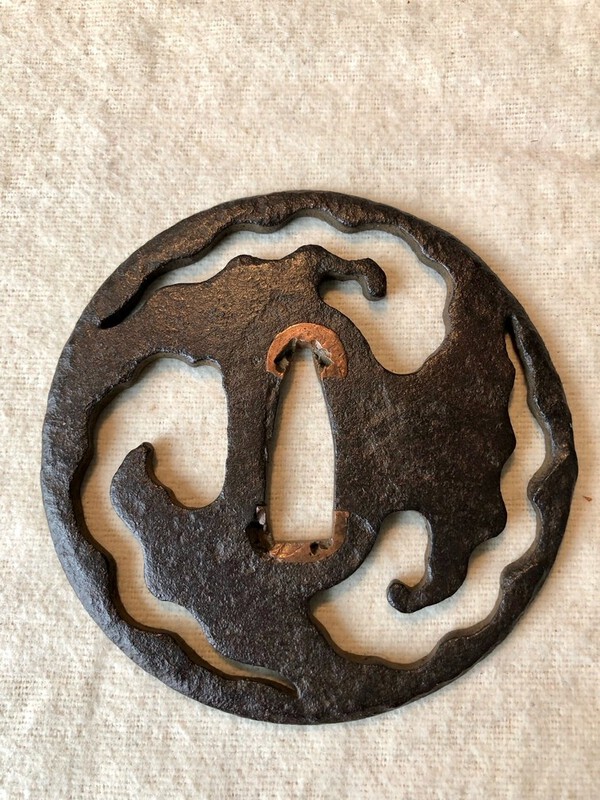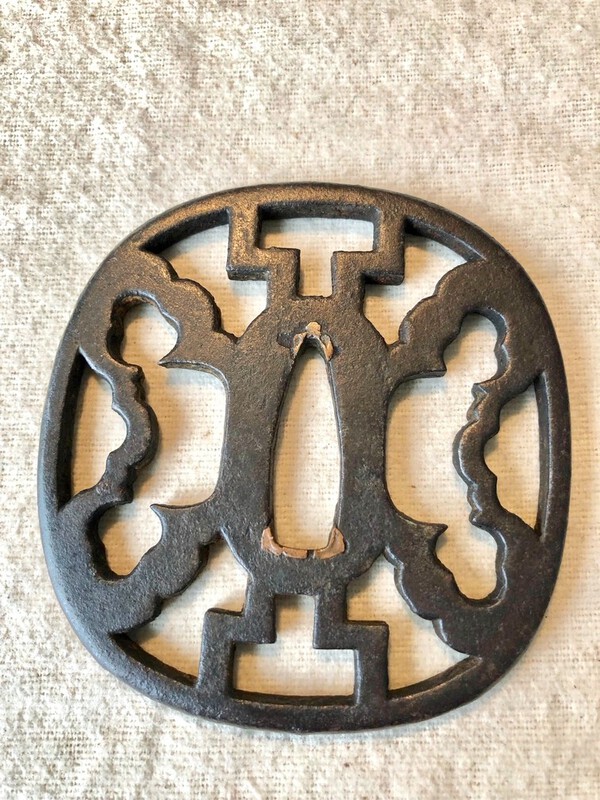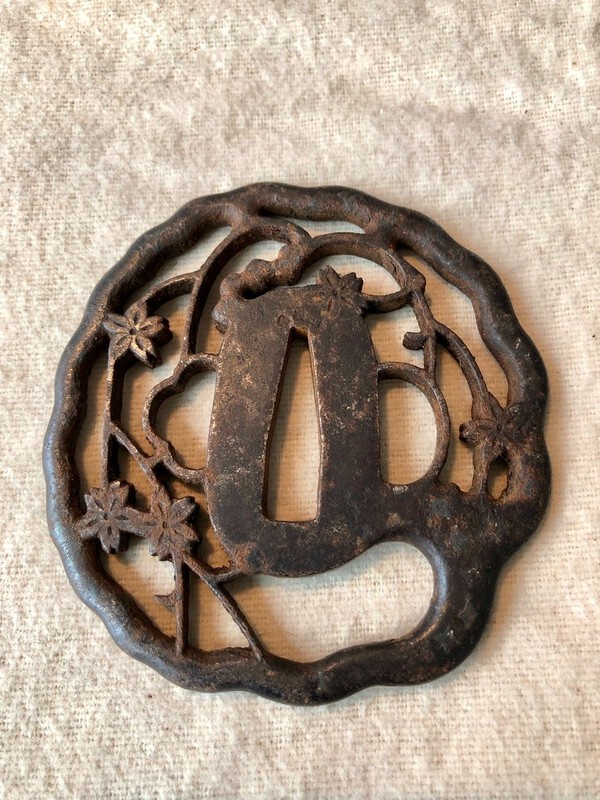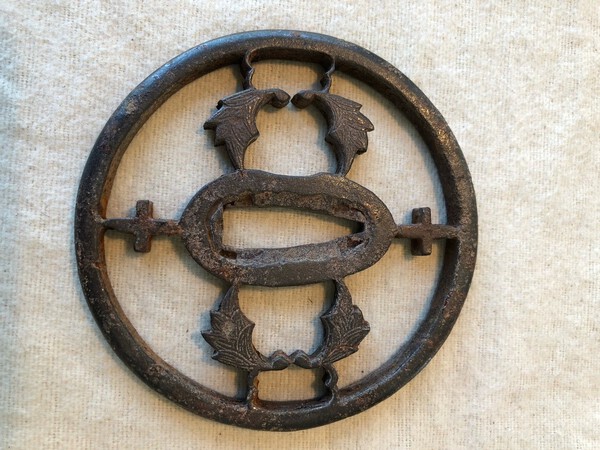-
Posts
927 -
Joined
-
Last visited
-
Days Won
4
Content Type
Profiles
Forums
Events
Store
Downloads
Gallery
Everything posted by Steve Waszak
-
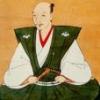
Selling a small collection of Iron tsuba
Steve Waszak replied to Steve Waszak's topic in For Sale or Trade
Okay, resuming with more tsuba now. . Tsuba #23. Ohno tsuba. Early Edo. Pronounced tekkotsu with snowflake motif. Mokko-gata. Excellent condition. 71.5 cm x 6.5 cm x 5mm. $375. Tsuba #24. Kiku-gata/motif. Fine kebori on the leaves. Excellent condition. 7.2 cm x 7.2 cm x 4.5mm. $250. Tsuba #25. Large maru-gata sword guard with motif of an umbrella. Fine tsuchime complemented by a light amida-yasuri on the plate. Beautiful color to this iron. There is a signature on the right side of the seppa-dai reading "Nobuie," though this is hard to see with the abrasions to the metal there. The rectangular hitsuana are very pleasing. 8.5 cm x 8.4 cm x 2.5mm. This is a strong tsuba. $650. -

Selling a small collection of Iron tsuba
Steve Waszak replied to Steve Waszak's topic in For Sale or Trade
HI Brent, Sorry about that. I just cleared some space in my PM inbox. In any event, I am holding tsuba #20 for you. -

Selling a small collection of Iron tsuba
Steve Waszak replied to Steve Waszak's topic in For Sale or Trade
Tsuba #19: 7.8 cm x 7.7 cm x 3.5mm. $90. Tsuba #20: 8 cm x 7.8 cm x 3.5mm. $100. *Note that this tsuba has had an impact at about 10:00 - 11:00 on the omote. See the metal that has been distorted here. Tsuba #21: 7.3 cm x 6.7 cm x 3.5mm. Kiri-mon motif. $100. Tsuba #22: 7.5 cm x 7 cm x 3mm. Yamakichibei-esque design and treatment. $100. All four for $300 plus shipping. -

Selling a small collection of Iron tsuba
Steve Waszak replied to Steve Waszak's topic in For Sale or Trade
Here is the next group: Tsuba #15: 7.3 cm x 7.3 cm x 4mm. $125. Tsuba #16: 6.5 cm x 6.5 cm x 3.5mm. $100. Tsuba #17: 7.1 cm x 7.1 cm x 3mm. $75. Tsuba #18: 8 cm x 7.9 cm x 3.5mm. $100. All four for $300. Plus shipping, of course. *Apologies for the sideways images. Not sure why they are loading that way... -

Selling a small collection of Iron tsuba
Steve Waszak replied to Steve Waszak's topic in For Sale or Trade
#12 and #13 are on HOLD. -

Selling a small collection of Iron tsuba
Steve Waszak replied to Steve Waszak's topic in For Sale or Trade
#11 is on HOLD. -

Selling a small collection of Iron tsuba
Steve Waszak replied to Steve Waszak's topic in For Sale or Trade
Tsuba #11: 8 cm x 7.8 cm x 5mm. Powerful Kiri-mon design. $175. Tusba #12: 7.4 cm x 7.4 cm x 3.5mm. $125. Tsuba #13: 7.9 cm x 7.7 cm x 2.5 - 3.0mm. $90. Tsuba # 14: 7.4 cm x 7.2 cm x 4mm. Good iron. $150. All four for $475, plus shipping. -

Selling a small collection of Iron tsuba
Steve Waszak replied to Steve Waszak's topic in For Sale or Trade
#7 on HOLD. -

Selling a small collection of Iron tsuba
Steve Waszak replied to Steve Waszak's topic in For Sale or Trade
Tsuba 1, 2, and 8 are on HOLD. -

Selling a small collection of Iron tsuba
Steve Waszak replied to Steve Waszak's topic in For Sale or Trade
Tsuba 4, 5, and 6 are on HOLD. -

Selling a small collection of Iron tsuba
Steve Waszak replied to Steve Waszak's topic in For Sale or Trade
Tsuba #10 is on HOLD. -

Selling a small collection of Iron tsuba
Steve Waszak replied to Steve Waszak's topic in For Sale or Trade
Next group up: Tsuba #7: 7.4 cm x 7.2 cm x 3mm. This piece has nice shakudo inserts for the hitsu-ana. Strong tsuchime on the plate. $125 Tsuba #8: 7.1 cm x 6.6 cm x 6mm. Two-piece construction. The motif may be a Christian reference. $90 Tsuba #9: 7.4 cm x 7.2 cm x 5mm. Irregular shape with mixed motifs. Not one you see everyday. $125 Tsuba #10: 8 cm x 7.0 cm x 4mm. An acid-etched motif. Ubu (no hitsu-ana). With some ivorying, this tsuba will look really good. $125 All four tsuba for $ $390. -

Selling a small collection of Iron tsuba
Steve Waszak replied to Steve Waszak's topic in For Sale or Trade
Next group: Tsuba #4: 7 cm x 6.5 cm x 3 mm. Tsuba #5: 7.2 cm x 7.2 cm x 3.5 mm. Tsuba #6: 7.4 cm x 7 cm x 3.5 mm. $90 each. $250 for the lot. Plus shipping. -

Selling a small collection of Iron tsuba
Steve Waszak replied to Steve Waszak's topic in For Sale or Trade
Tsuba #3 is on hold. Stay tuned for more... -
A good friend has asked me to help him sell a number of iron tsuba, most of which are at the "starter tsuba" level and/or make fine study pieces. I will be posting 2-3 pieces at a time, over the course of several days, beginning with the three below. Prices will be LOW, so if you're looking for an opportunity to acquire a handful of varied iron tsuba CHEAPLY, this is it. I will provide measurements on each tsuba, but not much more information (unless there is something of note to add, such as that a given piece is papered, etc...). I will not be trying to identify a "school" for each guard, either. Prices listed do not include shipping/postage. Because these tsuba are being offered at such low prices, I prefer to find buyers in the U.S., unless a non-U.S. buyer is looking to acquire several pieces at once. Please let me know if you have any questions, or are looking for a particular type of sword guard that I haven't posted yet. First come, first served. Steve Each of the tsuba here is being offered at $125. If you want all three, the price is $300. Tsuba #1 dimensions: 7.9cm x 7.8cm x 5.5mm Tsuba #2 dimensions: 7.5cm x 7.3cm x 4mm Tsuba #3 dimensions: 7.7cm x 7.4cm x 5.5mm
-
Rabbit menuki (ko-kinko?) on the aikuchi koshirae (17th century) for a Wakasa no kami Ujifusa tanto.
-

So what's a weird deal-breaker for you?
Steve Waszak replied to Brian's topic in General Nihonto Related Discussion
Since I'm more of a fittings guy, I'll mention that for tsuba, a deal-breaker is human-figure subjects. So, Soten guards have zero appeal. Dragons are another big turn-off. But the biggest NO for me is Namban tsuba, whose busyness and Chinese sensibilities are like a repellant. There are others, but these top the list. -
This motif and design were rather popular in the Momoyama Period. Here is an example by Kawaguchi Hoan. The addition of the gourds in gold and silver is intriguing, since chrysanthemum iconography can be tied to the imperial family and fealty to the emperor, and gourds (especially in gold) can be associated with Toyotomi Hideyoshi. The shodai Hoan worked for the Asano clan, so it is interesting to speculate on possible political allusions with this tsuba.
-

For Sale: High Quality Tsuba Stands - Wood | Acryl design
Steve Waszak replied to Kunehito's topic in Tsuba
Excellent, Tobi! -
What's fascinating about that particular piece is that it's mumei(!), the paper gives it only to "Den Nobuie," and the price is still this high. Of course, being published in the Nobuie Tsuba Shu is going to lift the value to a degree, but this seems like a lot to me. Personally, the one Fred has here -- https://www.nihonto.com/1-1-22/ -- is the strongest of these three.
-
I think Darcy's write-up explains very well the very high values genuine Nobuie tsuba enjoy. It also must be remembered that photos do not do justice to the true appearance of Nobuie (and many other) tsuba. In real life, true Shodai and Nidai works are stunning, featuring a depth of color and taking on a patina I have not seen matched by any other maker's work. I have some personal experience with the tsuba in Darcy's write-up: it is astonishingly beautiful in hand, but not so much in Darcy's photos. Knowing firsthand the difference between how Nobuie swordguards come across in photos compared to what they actually look like when being held, I imagine the tsuba in the Aoi listing is vastly superior to how it may come across in the photos.
-

Darcy Brockbank
Steve Waszak replied to Ted Tenold's topic in Sword Shows, Events, Community News and Legislation Issues
Really in too much shock to comment properly... Unfathomable loss. Deepest condolences to his family and friends. -
Ah, thanks, Glen, for the explanation. I appreciate it. Yes, I can see why you had these statements in your post, then. I guess I would just say that, while Nidai work can be as good as that of the two Shodai smiths, I wouldn't quite say it is on another (higher) level. His workmanship can be more complex, it is true (e.g. he will sometimes have, in combination, uchikaeshi mimi, extremely expressive tsuchime, brilliant tekkotsu, and the finest amida-yasuri of any tsubako in history, IMHO), but conversely, it doesn't quite attain the hugely expressive sculptural power of the work of O-Shodai, and it lacks the nuanced finesse often achieved by the Meijin-Shodai. None of these qualities would make one "better" than the other, objectively speaking, but subjectively, certainly, we might prefer the tsuba of one of these smiths to those of the other. In my view, all three are absolute masters. Interesting note: the Nidai has five Juyo pieces to his name, while the O-Shodai (Yamasaka Kichibei) has "only" four. However, it must be considered that there are far fewer O-Shodai pieces extant, so a much higher percentage of his known works are Juyo than is the case with the Nidai. This, incidentally, must be factored in when we are reviewing how many Juyo works exist for a given smith or "school": how many pieces made by a particular tsubako are there, and of these, what percentage attain Juyo levels? In some cases, there may be hundreds of pieces extant belonging to a certain maker or school, but "only" perhaps ten are Juyo; on the other hand, there may be only a few dozen works known by another master, but of these, ten are Juyo. This may suggest a higher "ranking" for the latter... I'll look forward to reading your further posts in this and other threads, Glen. Steve
-
Hi Glen, Good thoughts posted here. I was struck, however, by this statement: "Second generation Yamakichibei is more highly prized than the 1st gen founder for that entire style. The 2nd gen smith really took the designs and execution to a higher level." When you say that second-generation Yamakichibei is more highly prized than the first-generation founder, I'm wondering where this notion comes from. Do you have a source for this statement? And as far as the second-generation smith "really [taking] the designs and execution to a higher level," I'd also like to know the source for this sentiment. In my experience, neither of these is quite correct... Steve


